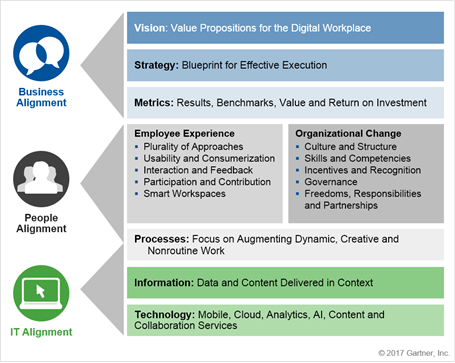Digital workplace programs often lose their way, or fail, due to a fragmented approach that prioritises a few technology “fixes” over business strategy, said Gartner, Inc.
To combat this, digital workplace leaders need to employ a framework to ensure their digital workplace initiatives address all of the eight critical components required for a successful implementation.
>See also: Worldwide IT spending forecast to grow in 2017 – Gartner
“The digital workplace promises a more flexible, engaging and intelligent work environment that is able to exploit changing business conditions,” said Carol Rozwell, vice president and distinguished analyst at Gartner.
“To be successful, a digital workplace can’t be built in a vacuum. It must be part of a wider business strategy that seeks to boost employee agility and engagement by developing a more consumerised work environment.”
Gartner has identified the eight critical components — “building blocks” — that application leaders need when planning, directing and evolving digital workplace programmes (see Figure 1).

1. Vision: describe what digital workplace success
Will Look LikeThe vision describes the future state of the digital workplace and howit will benefit all stakeholders. It should be consistent with the organisation’s values and serve as a source of inspiration to the stakeholders who will craft the strategy and tactics to realise the vision.
2. Strategy: create a roadmap to reach the destination
The strategy describes the approach an organisation will use to achieve its vision and create a digitally empowered workforce. It clearly defines the strategic roadmap to achieve the organisation’sbusiness goals.
>See also: CIOs: don’t declare war on business unit spending
3. Metrics: measure performance and value
How application leaders of digital workplace programmes measure the value of their initiatives should be an extension of the organisation’scurrent approach. Each initiative should be designed to have a positive impact on a business value metric, such as workforce effectiveness, employee agility, employee satisfaction and employeeretention.
Effective metrics also provide a feedback mechanism for continuous development of strategy and tactics, serve as great tools for change management, and help structure employee incentives.
4. Employee experience: design for improved employee interaction
Creating an excellent employee experience is a pivotal aspect of a digital workplace. An engaged, creative and energetic workforce outperforms the competition in terms of service delivery, execution and product design.
>See also: Driving digital business and mobility: guide for CIOs
“The aim should be to increase employees’ participation in any workplace redesign, in order to create an environment that will make them more effective and connect them better to the outcomes of the business,” said Rozwell.
5. Organisational change: start small but think big
As digital workplace initiatives mature, they require considerable change to an organisation’s internal processes, departmental structures, incentives, skills, culture and behaviour. Ultimately, digital workplace initiatives will affect every system, process and role within the organisation.
6. Processes: re-engineer how high-impact work is done
Digital workplace programmes are particularly powerful when they set their sights on increasing the effectiveness of people who do high-impact work. Such work benefits from more agile, responsive and collaborative processes that rely more on the ability to respond rapidly to changing circumstances.
>See also: Virtual workspaces solving the issue of cost
Re-engineering business processes requires a close look at how employees currently work, in order to design new work journeys. The new and improved ways of working will involve the addition of new tools to enable collaborative work, use of other new technologies and adaptation of outmoded processes.
7. Information: rework access and use of content and analytics
Workers expect enterprise tools for searching, sharing and consuming information to be as “smart” and compelling as those they use in their personal lives. They want information and analytics to be contextualised, based on their work, and delivered when they need it. By 2020, algorithms will improve the behaviour of over 1 billion workers.
8. Technology: take a platform approach to workplace investments
Application leaders responsible for digital workplace programmes must work out how to use technology to reach customers, internet-connected “things” and ecosystems.
>See also: Go-to market strategies for a secure IoT solution
They must also determine how new technologies such as artificial intelligence and the Internet of Things can enable more effective ways of working, and how to exploit the next wave of technology innovation without having to constantly re-architect.
The UK’s largest conference for tech leadership, Tech Leaders Summit, returns on 14 September with 40+ top execs signed up to speak about the challenges and opportunities surrounding the most disruptive innovations facing the enterprise today. Secure your place at this prestigious summit by registering here










